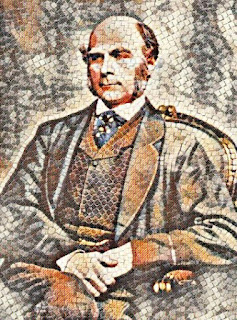Darwinist Hall Of Shame - The Eugenicists Wing Part Two! Francis Galton - Father of Eugenics. Charles Davenport, American Counterpart.
"Globally, there are an estimated 50 million abortions each year. That’s one abortion for every three live births, so any child in the womb, on average, worldwide, has a one in four chance of being deliberately killed..." - From the Russell Grigg article, below:
Eugenics...Planned Parenthood was born from the American Eugenics movement and over 100 million deaths from genocide were perpetrated in the 20th Century alone....without counting the myriad baby murders that we euphemistically call "abortions." Eugenics is an excuse for racism, sterilization and murder. With Darwinism as a pseudo-scientific excuse for Atheism and genocide, Social Darwinism has killed more victims than the Black Death...and the toll keeps growing and growing...
Francis Galton (featured on right in photo montage, right) was born into a Quaker family in Birmingham, England, in 1822. A grandson of Erasmus Darwin on his mother’s side and so a cousin of Charles Darwin (pictured above left), he shared the Darwinian agnosticism and antagonism to Christianity for most of his adult life.
We use the word, "Eugenics," but it is one of those words that is far more heinous than the apparently innocent name. Just as "abortion" is actually "baby-murdering." Eugenics is a word that has an evil history, no matter how modern Darwinists seek to sanitize it now. Eugenics was the concept of "breeding out" the "inferior" stock of humankind. In other words, murder - genocide - holocaust - choose your term.
A letter from Teddy Roosevelt to Charles Davenport (the American Francis Galton) is instructive, if you care to read it? At the end, Teddy states that "...we have no business to perpetuate citizens of the wrong type."
If smart farmers could breed better livestock, why couldn't smart
scientists breed better humans? A growing segment of America's upper
crust pondered this question around the turn of the 20th century, and
the movement found a standard bearer in Charles Davenport.
Davenport became the director of the Biological Laboratory at Cold
Spring Harbor in 1898, and shortly afterwards applied for funds from the
Carnegie Institution of Washington to support his studies in heredity.
He had to wait three years for the funding to arrive, but when it did,
he resigned his professorship at the University of Chicago and began
devoting himself full time to research.
Eugenics...Planned Parenthood was born from the American Eugenics movement and over 100 million deaths from genocide were perpetrated in the 20th Century alone....without counting the myriad baby murders that we euphemistically call "abortions." Eugenics is an excuse for racism, sterilization and murder. With Darwinism as a pseudo-scientific excuse for Atheism and genocide, Social Darwinism has killed more victims than the Black Death...and the toll keeps growing and growing...
 |
| Francis Galton, 1850s, colorised at Palette.fm, modified again at LunaPic |
Eugenics … death of the defenceless
. . .
Few ideas have done more harm to the human race in the last 120 years
than those of Sir Francis Galton. He founded the evolutionary pseudo-science of
eugenics. Today, ethnic cleansing, the use of abortion to eliminate ‘defective’
unborn babies, infanticide, euthanasia, and the harvesting of unborn babies for
research purposes all have a common foundation in the survival-of-the-fittest theory
of eugenics. So who was Galton, what is eugenics, and how has it harmed humanity?
Francis Galton (featured on right in photo montage, right) was born into a Quaker family in Birmingham, England, in 1822. A grandson of Erasmus Darwin on his mother’s side and so a cousin of Charles Darwin (pictured above left), he shared the Darwinian agnosticism and antagonism to Christianity for most of his adult life.
~~~~~~~~~~~~~~~~~~~~~~~~
We use the word, "Eugenics," but it is one of those words that is far more heinous than the apparently innocent name. Just as "abortion" is actually "baby-murdering." Eugenics is a word that has an evil history, no matter how modern Darwinists seek to sanitize it now. Eugenics was the concept of "breeding out" the "inferior" stock of humankind. In other words, murder - genocide - holocaust - choose your term.
A letter from Teddy Roosevelt to Charles Davenport (the American Francis Galton) is instructive, if you care to read it? At the end, Teddy states that "...we have no business to perpetuate citizens of the wrong type."
Citizens of the "wrong type" included all people of color, any diseased or impaired folks, as well as various types of European immigrants not palatable to Davenport and of course Jews. Read the letter and then let's take a look at Davenport next, an American champion of Eugenics:
 |
| Charles Davenport, 1929 |
Charles Davenport
Murder is murder. The Aborigine hunted down to be skinned, the baby in the womb, the kid with the yellow star on his shirt, the peasant who doesn't agree with the tyrant, the former slave that elitists believe is inferior because some people like Charles Darwin and Francis Galton said so? God says otherwise. Choose which you will trust, the so-called wisdom of man or the Word of God?